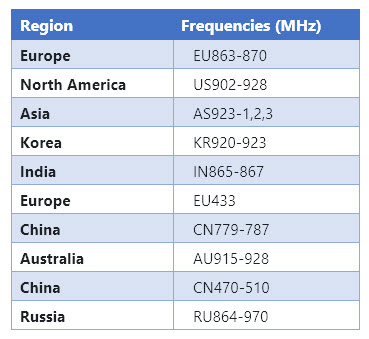The ISM Band and LoRaWAN Regional Parameters
One of the biggest advantages of
LoRaWAN is that it uses unlicensed ISM bands around the world. This radio
spectrum is reserved regionally for industrial, scientific, and medical (ISM)
devices and LoRaWAN devices make use of this spectrum.
This means that users don’t need to purchase expensive licenses to operate their devices, or pay a network operator for the use of their licensed band.
Anyone can operate a LoRaWAN device or network—anywhere in the world—provided they comply with the regulatory requirements for that region or territory.
The International Telecommunication Union (ITU) manages the common spectral use for the United Nations (UN), but the final frequency assignment authority is granted by the governments of each country or region, and there are more than 200 of these entities.
However, many small and developing countries have no frequency-assignment authority in place. This creates a complicated scenario for worldwide LoRaWAN deployments. For a global LoRaWAN network to be successful, it is important that people throughout the LoRaWAN ecosystem who plan to deploy such a solution understand the regulatory requirements in the locations where they plan to deploy their networks and devices.
The types of parameters defined by the regulatory requirements include:
- Frequency to be used
- Maximum TX power and power configuration
- Frequency-hopping requirements
- Duty cycle or dwell time restrictions
- Whether listen-before-talk (LBT) is required
To assist in the development of worldwide LoRaWAN networks, the LoRa Alliance specifies the configuration of these parameters so that a LoRaWAN network can be compliant in each region, country, or territory. The Channel Plans for each country or region are defined in the LoRaWAN Regional Parameters specification, which is a companion document to the LoRaWAN Layer2 (L2) protocol specifications. The Regional Parameters specification addresses the regulatory and operational requirements for LoRaWAN Networks, and can be found on the LoRaWAN for Developers page of the LoRa Alliance website.
|
The LoRaWAN Regional Parameters specification document defines the following parameters:
|
 Common Channel Plans by Region |
|---|
As the various regulatory authorities periodically define and change their requirements, separating regional parameters from the protocol specification has allowed regions to be added or changed without impacting the LoRaWAN L2 specification.
To learn more, watch this:

(Time: 5:14 minutes)